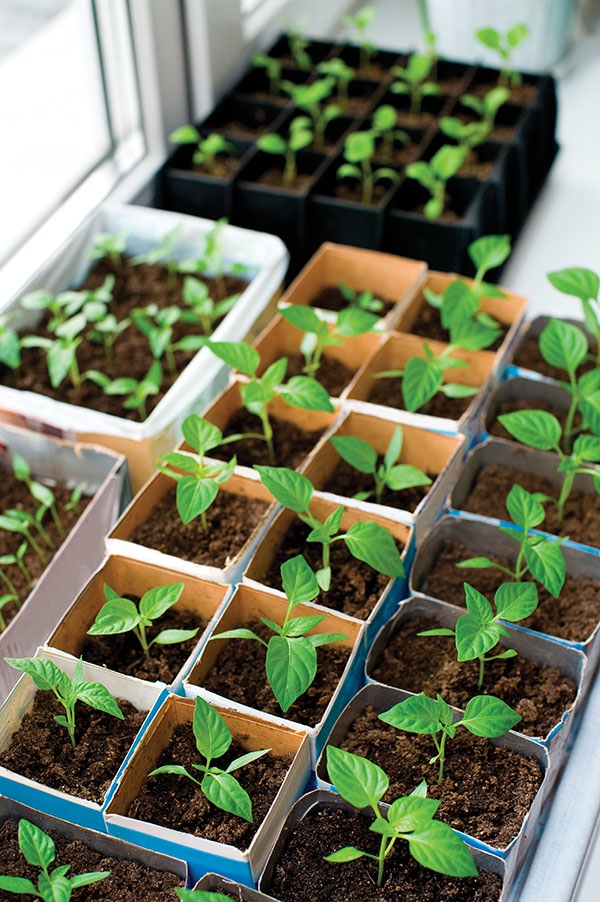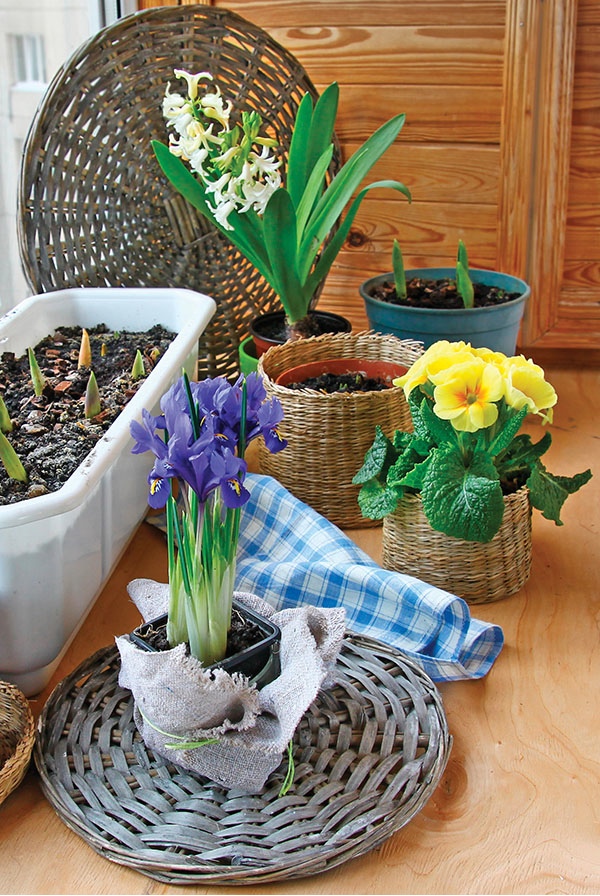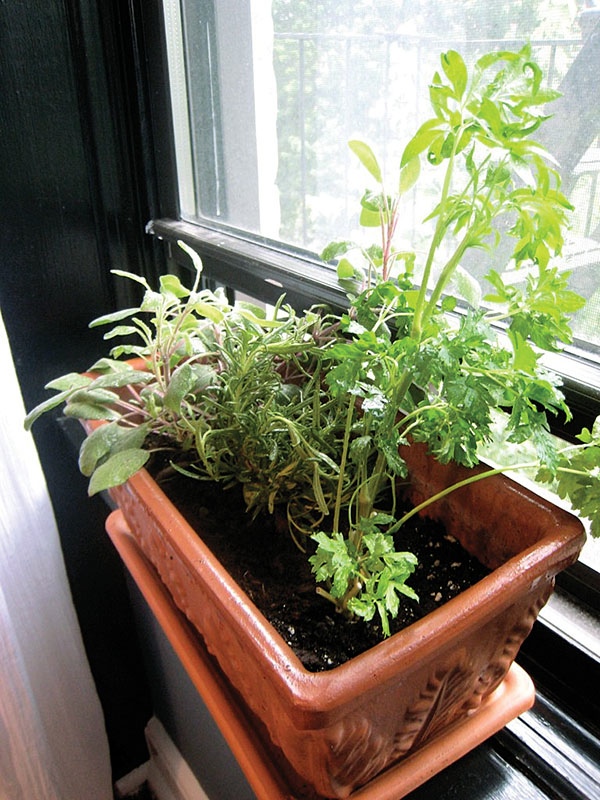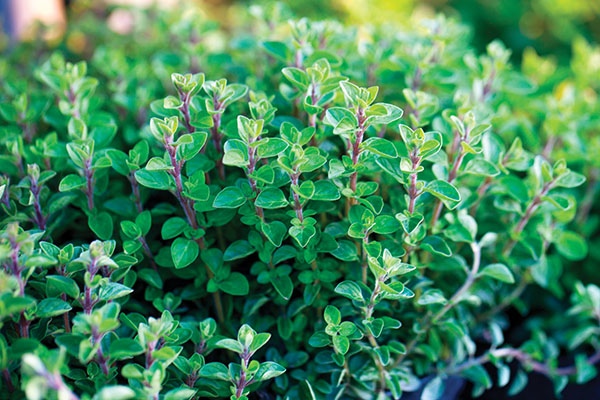Project 1: Windowsill Herb Gardens
Why would you want to do this? You really want to try growing your own food, but you have no outdoor gardening space. Plus, herbs are easy to grow and great to have on hand.
Why wouldn’t you want to do this? You don’t want to grow plants, you don’t cook much, or you don’t use herbs in cooking.
How does this differ from store-bought versions? Many purchased herb plants are heavily fertilized, so they may be lusher than yours, but your homegrown herbs will be more flavorful.
Cost comparison: It is far more expensive to buy dried herbs than it is to dry some branches or leaves from your own plants.
Learn more about it: Visit the Windowsill Gardening page on the Harvest to Table website (http://harvesttotable.com/2010/01/windowsill_gardening_growing_v/) and check out The Kitchen Garden Grower’s Guide (BookSurge, 2008), both by Master Gardener Stephen Albert.
Further refinements: Culinary uses are practically limitless, and you can create plenty of personal and household products from your homegrown herbs.

Even if your only exposure to the outdoors comes when you exit the front door of your apartment building and set foot on the city sidewalk, you can still have a garden. If you have a windowsill—or even just a window—you can grow delicious additions to your table.
Herbs are among the most expensive items in the grocery store, and it always surprises me that anyone who can grow his or her own herbs would buy them. One of the reasons that herbs are so widely used in cooking is they are easily cultivated. Many of them count as weeds in their native areas and have growing traits that follow suit: they can grow in extreme conditions, have large yields, and attract pollinators when grown outdoors. The end result is durable plants that are tasty, edible, and healthy.
Because they are easy to grow and do not need much space, herbs have become very popular indoor plants. Sunny city and suburban windowsills around the world are alive with the popular basil, thyme, rosemary, oreg-ano, and sage, as well as more exotic herbs. Most “aromatic” herbs serve as beneficial companion plants for other edibles, and many can be grown together in a container to mutual benefit.

Certain flowering plants also fare well indoors.
One of the many things I like about windowsill gardens is how good the plants always look. I think that indoor plants are typically nice and healthy because they get so much care. They are small, it takes no time at all to water and trim them, and you won’t have any weeds to deal with. Because mine are right above my kitchen sink, I look at them and give them attention throughout the day, every day. Instead of dumping my half-full water glass down the drain, I give the water to my plants. They get steam when we do the dishes, they bask in morning and midday sun, and they enjoy the ambient temperatures of our most inhabited room. It’s a symbiotic relationship: I nurture the plants, and they reward me with good food or flavorful spices or even a soothing salve (from the aloe vera plant, good for cooking burns), as well as pretty decor. If you can find several containers that look nice lined up side by side, you’ll have the makings of a lovely windowsill garden, a little oasis of your own.
Materials:
•Small planters or containers
•Drip trays
•Potting soil
•Small rocks (to help with drainage)
•Herb plant starts
•Small kitchen shears
Step 1: Find three to five containers that fit on your windowsill. This is where your creativity comes in: use tin tea containers of different colors. Use bright ceramic mugs, either a matched set or several in different colors and sizes. Get a series of small to medium terra-cotta pots and a large drip tray (washed Styrofoam meat trays make good drip trays) to set them in, and paint the rims with patterns or your favorite quotations. Line up three or four interesting bowls. Collect the cans from a few weeks’ worth of soup, tear off the labels, and use clear packing tape to seal interesting photos to the outside of each can. Alternatively, you can use one long, thin container that fits the length of your windowsill, such as a piece of copper or aluminum gutter with ends attached. Whatever you do, don’t spend a bunch of money—you can find plenty of options around the house.
Step 2: Put drainage holes in the bottom(s) of your container(s) (ceramic containers are particularly challenging, so unless you know how to drill holes in them—with a special drill bit and a ton of patience—skip this step) and place the containers on a drip tray. Put a layer of rocks on the drip tray to help keep the root zone from getting too soggy and to create more humidity around the plants.
Step 3: Fill all of the containers three-quarters full of potting soil.
Step 4: Plant small herb plants in each container. If the container is large enough, you can plant more than one plant in it, either several of the same herb or a few different herbs. Good herbs for small containers are thyme, rosemary, parsley, and small-leafed basil. You can also try a small hot-pepper plant, such as cayenne or ornamental.
Step 5: Top the containers with soil at the plant bases, firming the soil around the edges. Give the pot an initial soaking, both to settle the soil and to make certain there is good root-to-soil contact.
Step 6: Water the plants carefully—you want them to dry out, but not become parched, between waterings (see Drainage Tips sidebar for advice on planters without drainage).
Step 7: Initially, trim your herbs for kitchen use lightly. Once the plants are established, you can trim them more regularly—this will encourage growth, which in turn encourages root growth (more roots take up more water, which helps prevent waterlogging).
Drainage Tips
If a container does not have drainage holes, put a layer of pea gravel an inch or two thick in the bottom of the planter, place a used dryer sheet over the gravel, and put the soil on top of the dryer sheet. This will prevent your plants’ roots from rotting by giving the standing water a reservoir. Be judicious when watering pots that have no drainage; they should only receive water when the soil feels like it is drying out. To be certain, you might want to occasionally dig your fingers down below the top surface to see whether it’s damp at all.

A sunny windowsill is the perfect spot for indoor herbs.
Plants for a Basic Indoor Herb Garden
This is just a partial list of herbs that you can grow easily in your garden, yielding plenty to harvest fresh and to dry for use when the plants are dormant. You may never buy basic herbs from the grocery store again!
Basil: This leafy green plant is a perennial that most of us treat as an annual. It is cheap and easy to start from seed, and it likes a lot of heat. Basil prefers full sun but can actually sunburn in hot climates. It is not one of the more drought-tolerant herbs; give it water regularly to ensure plentiful bright-green growth. Too much water and not enough light will yield long, leggy stems and smaller leaves. There are many different varieties beyond the basic flat-leafed green type. Try purple leaves or lemon-flavored basil for a change of pace. Some basil plants have leaves as large as lettuce leaves; others have plentiful, tiny, spicy leaves.
Chives: Chives are relatives of the onion and are incredibly versatile. They are a culinary delicacy of sorts because they don’t store well and they lose their pungency when dried. Chives grow from a cluster of bulbs and will readily grow back year after year (and month after month), multiplying their bulbs annually. They should be dug up and divided every three to five years. The chive “leaves” can be trimmed in small handfuls and snipped fresh over many different foods, or they can be chopped and cooked for a gentler, more nuanced flavor. Let your chives flower—the pretty pincushion flowers are edible. You can take individual blossoms from the round flower head and add them to a salad or on top of pasta. Each flower gives a tiny burst of chive flavor and adds color.
Cilantro: This annual herb is easy to start from seed but is hard to grow as the green leaf we all know and love in salsa. I start a pinch of seeds (at least six) in a single pot and give it good light (but not too much full sun) and lots of water for ample leaf growth. If it dries out, it will bolt, which means that it is under stress (“Aaaack! Life in peril! Must reproduce before I die!”) and will send up a flower/seed stalk. The silver lining when cilantro bolts: the seeds that form are coriander, another spice. If you let it bolt, collect the seeds when the tops are brown and dry. Grind some of the coriander in a coffee grinder, and you’ve got a staple seasoning in Indian and Cajun cooking; plant the rest of the seeds for cilantro next year.

Oregano is a prolific grower whether outdoors or indoors.
Oregano: I love oregano and use it in much of our cooking, but I get irritated that it overruns less aggressive herbs. There’s only so much oregano that one can use fresh, and I still have plenty left to dry. This is a hearty plant that can be found on the dry, rocky slopes of the Mediterranean; there are Greek and Italian varieties and lots of choices in leaf and flower color and size.
Parsley: This nutrient-packed green normally grows for two years (a biennial), putting on the leafy growth in the first year for maximum photosynthesis to nourish the root. In the second year, the root uses that stored energy to send up a few leaves and a prominent flower head that then yields the seeds for next year’s new plants.
Rosemary: People who enjoy Greek food recognize the importance of rosemary in Mediterranean cooking. This is an aromatic herb with both upright and prostrate varieties. Rosemary tolerates extreme heat and drought better than cool, moist conditions.
Sage: The Salvia genus is one of the largest in the plant world, and there are so many varieties to choose from. On the edible varieties, you’ll find leaves in different sizes and colors—from green to bluish green to purple to variegated— as well as flowers in almost all shades of the rainbow. The standard culinary sage is a good, hearty plant and is yet another indispensable cooking herb. Some sage flowers are edible and make lovely salad additions.
Thyme: Thyme is one of the most popular herbs from my herb garden. Thyme likes a warm area and needs good drainage. It will overwinter in cooler climates as long as it is not waterlogged. Thyme is a low grower and can go in a pot with more upright herbs or at the edge of a planter, where it will creep and cascade down the sides. There are many different varieties of this herb, from regular culinary thyme to lemon, lime, variegated, and other types. It is indispensable in cooking.’

The easy-to-recognize parsley (left) is a biennial plant. Rosemary (center) is flavorful and aromatic. The different varieties of thyme (right) have many uses in the kitchen.
Dry Your Herbs
Long method: Hang branches or leaves from a rafter in a warm, dark spot with plenty of air circulation, such as an attic in the summer or a warm furnace room. Leave them hanging until the leaves crumble to the touch.
Quick method: Spread leaves in a single layer on a paper towel. Microwave on high for three to four minutes or until the leaves crumble to the touch.
Store dried herbs in sealed containers in a dark place away from light and heat. Try to dry and store only what you’ll use in a few weeks’ time because the oils that give them their flavors will degrade.